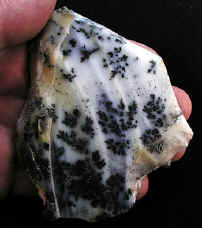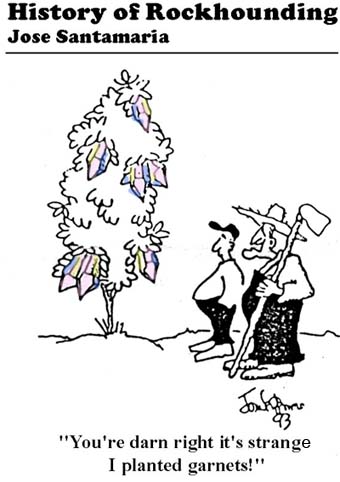| SRGMS Newsletter | Feb 2009 |
|
Goat Mountain Moss Agate - Stoneyfield, CA
Moss agate was thought to insure a green thumb to one wishing to plant a garden. It was also believed to heal the pain of a stiff neck and to assist in locating lost treasure.
The moss agate is translucent to snow white, with plentiful black inclusions of moss like dendrites and containing occasional small pockets of drusy quartz crystals. Some of the material
has mustard yellow speckling.It makes fabulous cabochons and is great for tumbling.

Given our dry winter, this 3 hour drive into Mendo County would be a perfect weekend rockhounding trip. You will need a vehicle with high clearance or 4x4 is strongly recommended since the collecting spots are located on mostly dirt roads, some maintained, some not. Bring your rock pick and collecting bag, and wear layered warm clothes since you will be in the Alpine mountain at about 6,000 feet elevation After an afternoon of rockhounding, be sure to check out near by Letts Lake Recreation area and historic old gold claim. Fishing and camping is also available.
Finding the Site: Rockhounding California
|
|
|||||||||||||
|
Featured Mineral for February Feldspars & Their Gems - Merle Hamilton February 1978 Feldspar is the most abundant mineral on earth. There are two large groups of feldspars, the potassium and the plagioclase, with many sub-divisions in each. All are silicates, which means they contain silicon and oxygen, and they also contain sluminum. Potassium feldspars are potassium aluminium silicates. However, plagioclase feldspars contain sodium and calcium in varying amoutns. Albite and anorthite are the end members in a complete solid solution series. This is not as complicated as it sounds. The melt for plagioclase contains silicon, oxygen, aluminum, sodium and calcium. As it cools and starts to form feldspar crystals, the sodium atoms enter the freamework in great numbers, forming albite, the sodium rich end member.The melt continues to cool and a few calcium atoms join with more of the soidum in new feldspar crystals, forming oligoclase. The process continues, with about half sodium and half calcium, in labradorite. Now the sodium is getting scarce and the calcium abundant in bytownite. And lastly there is practically no sodium and all calcium in the framework of anorthite the calcium-rich end member. There are so many feldspar mineral that it is often very difficult to distinguish one from the other. They all have squarish of blocky crystals, cleavages nearly at right angels and a hardness of 6 on the Mohs scale. Twinning provides a way to tell the difference between plagioclase and potassium feldspars. In plagioclase, numerous thin crystals are sandwhiched together, resulting in perfectly straight striations on the cleavage planes. These thin lines are lacking in potassium feldspars. In indentifying rocks, it is always best to know the exact locality they came from and nature of their associated rocks. |
|
In The News... Rare mineral might tell us global warming's state over next two centuries Entertainment & Showbiz - Other news The study of a rare mineral, which can be used to track ancient climates, will help scientists estimate what will be the condition of the world over the next century or two, as global warming begins to crank up the heat. Tim Lowenstein and his colleague Robert Demicco at Binghamton University have discovered that nahcolite, a rare, yellowish-green or brown carbonate mineral, only forms on earth under environmental conditions marked by very high atmospheric CO2 levels. That establishes it as both a marker and a benchmark that can be used by scientists as they consider the likely climatic implications of ever-increasing CO2 levels in our atmosphere today. More specifically, nahcolite suggests that Eocene warming was concurrent with atmospheric CO2 levels of at least 1,125 parts per million (ppm), which is 3 times the current levels of 380 ppm, but not all that much higher than we can expect on earth in the next 100 years or so given generally accepted scientific projections based on fossil-fuel consumption. Because CO2 is a forcing factor for climate change, increases in its levels can be directly tied to global warming. A greenhouse gas, CO2 absorbs radiation that would normally be reflected out of the atmosphere, helping to ramp up temperatures, melt glaciers and significantly alter ocean currents and weather patterns. As for steep, projected increases in CO2 levels over the next century, Lowenstein thinks that might not be our only cause for concern. "Right now, we're on a predictable pace. But, there will likely be tipping points, unexpected events that could really change things, so all of a sudden, we may get changes in ocean circulation that we never would have predicted, or the tundra may melt," he said. "Some unexpected event is going to occur that's going to be more dramatic than the progressive changes that occurred over the last 100 years," he added.
According to Lowenstein, although it is difficult to predict how global temperatures over the coming centuries will compare to the Eocene, the "hothouse"
world 50 million years ago should serve as a reminder of what global changes are possible. (ANI)
|
|
Years of Experience Shared... Drilling Holes In Agate Slices - Steve Breccia Equipment: You will need a sturdy drill press that will turn fast about 10,000 rpm. The old metal ones are good, since the newer ones tend to flex some. You can purchase a metal drill stand at a yard sale for under $10 and mount a rotary tool on it, and that works well also. Do not use the Covington Gem Drill to drill agates, as it goes too slow (it's ment for softer stones). Drill Bits:I start with a small hole. If it needs to be bigger, I ream it out. It is much easier to drill a small hole than a big one. I start out with a 1.4mm diamond bit, then I ream it with a 1.8mm triple ripple diamond bit -this bit if fluted and tapered, and use it only as a reamer. Coolant:I use Kingsley Tool Cool to keep the bit cool. You will need a shallow container to hold the stone to be drilled and the collant. I put a thin wood backing under my stone so that the bit does not puncture my container as the bit comes through the back of the stone. Put just enough coolant in the container to cover the stone. The Method: Now, here is the secret: use light pressure and a rapid up and down motion. This will keep the diamonds on the bit cool and lubricated. Too much pressure, and you will fry your bit or break your stone. If you do not go up and down fast enough, you will burn the bit up. You will find there is a rhythem to it and within a few slabs you should be into it. Yield: I get 8-12 holes out of my 1.4mm bits and about 100 holes ith my 1.8mm triple ripple bit (remember, this bit is just used as a reamer, not as a drill bit). I use kingsley North bits - their cheap ones- if you can call them cheap. |
| SRGMS Newsletter | Continued |
|
Fees are based upon $10/hr instruction. 30% of all class fees are turned over to SRMGS.
Intro to Gem Carving 6 hours
Intro to Lost Wax 9 hours
1 (low) to 5 (high).
Upcoming trip
Join us to explore the SF Academy of Sciences! Buy your tickets early and SAVE!! For more information on the preticket prices,
see the article above in the newsletter or check out the fieldtrip section on the website.
|


 We love to have more active members. Attend one or more of the SRMGS Meetings to get the most out of your membership! Meetings are held at the SRMGS Workshop.
We love to have more active members. Attend one or more of the SRMGS Meetings to get the most out of your membership! Meetings are held at the SRMGS Workshop.

